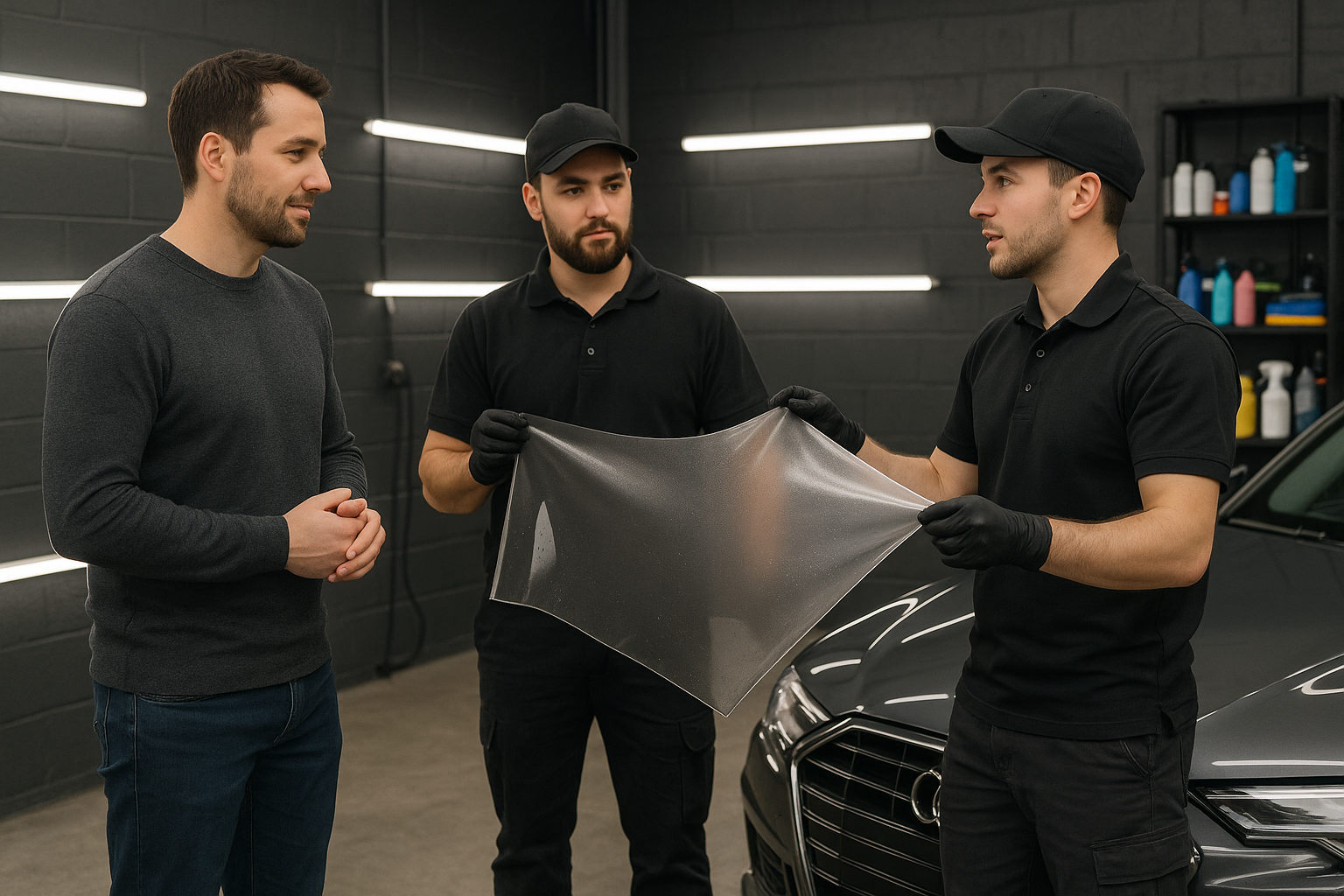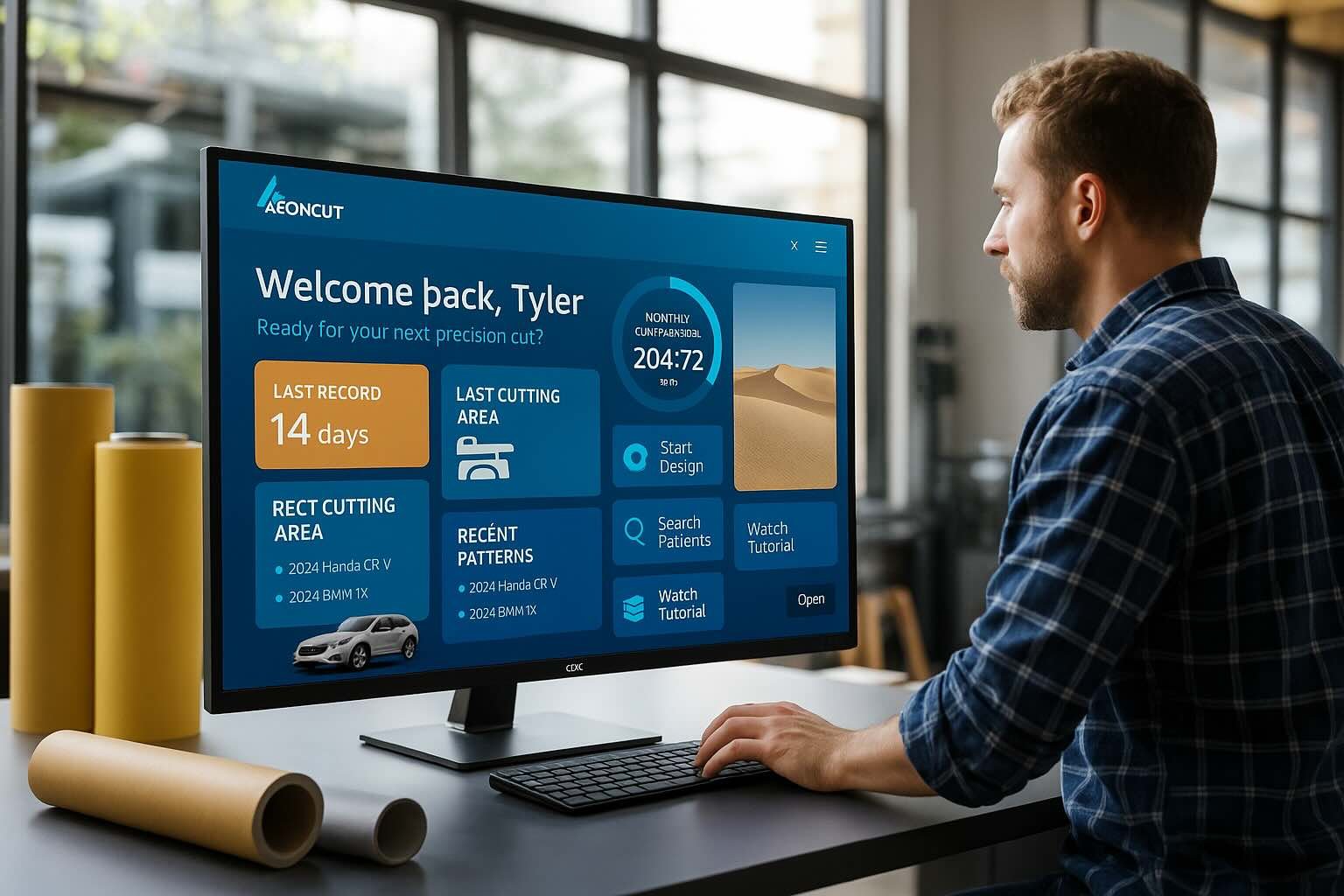Paint Protection Film is everywhere now and professionals rave about its sleek finish and impressive durability. Believe it or not, some films can cost as much as £4,000 for a full installation and still only last five to ten years. Most would expect something this expensive to be flawless. In reality, the real art lies in the skill of the installer and not just the technology—meaning even luxury cars can end up with bubbles and peeling if not applied by an expert.
Table of Contents
- Understanding The Benefits Of PPF Installation
- Key Drawbacks And Challenges With PPF
- Best Practices For Maximising PPF Performance
- Future Trends In PPF For Auto Professionals
Quick Summary
| Takeaway | Explanation |
|---|---|
| PPF offers superior vehicle protection | Paint Protection Film shields against road debris, UV rays, and minor damage, ensuring aesthetics and longevity. |
| Expert installation is crucial | Proper application requires specialized skills to prevent flaws that can diminish PPF effectiveness and visual appeal. |
| Educate clients on maintenance | Clear guidelines on cleaning and care enhance PPF longevity, maintaining vehicle appearance and protection. |
| Financial investment considerations are key | Installation costs range significantly, and potential replacements add to long-term expenses, requiring careful communication with clients. |
| Future trends include smart PPF technologies | Innovations in PPF will lead to intelligent films with responsive capabilities, enhancing protective performance and user experience. |
Understanding the Benefits of PPF Installation
Paint Protection Film (PPF) represents a critical investment for automotive professionals seeking to deliver superior vehicle protection and aesthetic preservation. Professional installers recognize PPF as a sophisticated solution that goes far beyond simple surface coverage.
Performance and Protective Capabilities
The protective qualities of PPF are remarkably advanced. According to research from SAE International, polyurethane-based protection films provide exceptional defense against multiple environmental threats. These films create a robust barrier that shields vehicle paintwork from road debris, ultraviolet radiation, chemical contaminants, and minor abrasions.
Professional installers understand that PPF offers multilayered protection. The film’s self-healing properties allow minor scratches and swirl marks to disappear under moderate heat, maintaining the vehicle’s pristine appearance. This technological innovation means reduced long-term maintenance costs and enhanced vehicle aesthetics.
Economic and Value Preservation Benefits
Beyond immediate protection, PPF represents a strategic investment for vehicle owners. The film helps maintain a vehicle’s resale value by preventing paint degradation and preserving the original finish. Professional detailers recognize that potential buyers consistently prefer vehicles with minimal paint damage.
The economic advantages extend beyond aesthetic preservation. By minimizing potential paint repairs and protecting against environmental damage, PPF offers a cost-effective solution for vehicle maintenance. Our comprehensive guide on paint protection benefits provides deeper insights into these economic considerations for automotive professionals.
Installation Precision and Professional Expertise
Successful PPF installation demands exceptional skill and precision. Professional installers must understand substrate preparation, film alignment, and application techniques to ensure optimal results. The film’s effectiveness directly correlates with the installer’s expertise.
Modern PPF technologies require advanced cutting techniques that minimize material waste and maximize coverage. Professionals utilizing sophisticated cutting software can create custom patterns that provide seamless, precise protection across various vehicle surfaces. This level of precision transforms PPF from a simple protective layer into a tailored automotive enhancement.
The evolution of PPF technology continues to offer automotive professionals innovative solutions for vehicle protection. By understanding these benefits, installers can provide superior services that meet the growing demands of discerning vehicle owners who seek comprehensive, long-lasting paint preservation strategies.
Key Drawbacks and Challenges with PPF
While Paint Protection Film (PPF) offers remarkable benefits, professional installers must understand its inherent limitations and potential challenges. A comprehensive evaluation reveals several critical considerations that can impact installation quality and client satisfaction.
Installation Complexity and Technical Challenges
PPF installation demands exceptional precision and technical expertise. According to automotive detailing experts, improper application can lead to significant aesthetic and functional issues. Common installation challenges include air bubble formation, uneven edges, and film misalignment. These imperfections not only compromise the film’s protective capabilities but also diminish the vehicle’s visual appeal.
Professional installers must invest considerable time in training and developing advanced techniques. The intricate process requires specialized tools, meticulous surface preparation, and an understanding of different vehicle geometries. Inexperienced technicians risk creating visible defects that can undermine the entire protective investment.
Financial Considerations and Long-Term Costs
The economic aspects of PPF present notable challenges for both installers and vehicle owners. Research indicates that installation costs can range dramatically from $500 to $5,000, depending on vehicle size and film quality. This substantial initial investment may deter budget-conscious clients and require careful value proposition communication.
Moreover, PPF is not a permanent solution. Automotive protection studies reveal that most films have a lifespan of 5-10 years before requiring replacement. Environmental factors such as extreme temperatures, UV exposure, and harsh chemical interactions can accelerate film degradation. Installers must transparently discuss these limitations to manage client expectations effectively.
Material Performance and Environmental Limitations
Despite advanced technologies, PPF is not invincible. Certain environmental conditions can significantly impact its performance and longevity. Harsh climates, prolonged sun exposure, and aggressive chemical contaminants can compromise the film’s protective properties. Professional installers must educate clients about proper maintenance and realistic performance expectations.
Some film variations struggle with specific challenges. Yellowing over time, reduced self-healing capabilities in older films, and potential paint interaction during removal are critical considerations. Learn more about advanced PPF application techniques to mitigate these potential drawbacks.
Successful PPF implementation requires a nuanced approach. By acknowledging and addressing these challenges, professional installers can develop strategies that maximize film effectiveness while maintaining transparent client relationships. The key lies in continuous education, technological adaptation, and a commitment to delivering superior automotive protection solutions.
Below is an overview table summarising the main drawbacks and challenges associated with PPF, helping installers quickly identify key concerns.
| Challenge Area | Description | Impact on Installers/Clients |
|---|---|---|
| Installation Complexity | Requires advanced skill, risk of bubbles and misalignment | May result in visible defects if not expertly done |
| Financial Investment | High upfront costs (£500–£4,000+) and need for eventual replacement | Significant cost requires value justification |
| Material Lifespan | Typical durability 5–10 years, not permanent | May need full replacement, added future expenses |
| Environmental Limitations | Susceptible to UV, chemicals, and harsh climates | Can degrade faster in tough environments |
| Maintenance Requirements | Needs careful cleaning, periodic checks and specialised care | Ongoing attention needed for optimal performance |
| Old/Low-Quality Film Issues | Prone to yellowing, diminished self-healing, removal risk | May affect vehicle aesthetics and safe removal |
Best Practices For Maximising PPF Performance
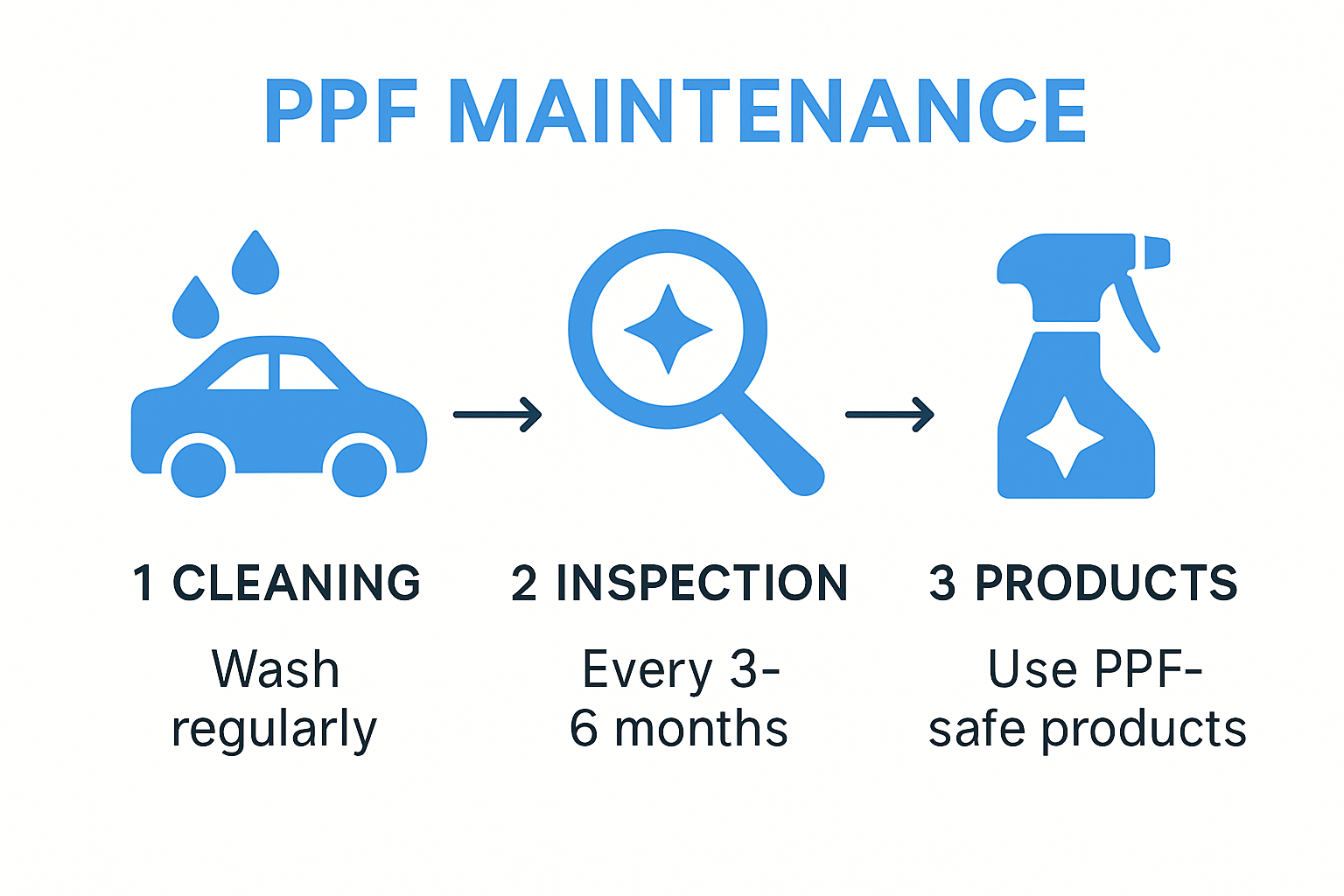
Paint Protection Film (PPF) represents a sophisticated automotive preservation technology that requires strategic maintenance to ensure optimal performance and longevity. Professional installers must educate clients about comprehensive care strategies that extend the film’s protective capabilities.
Precise Cleaning and Maintenance Protocols
According to automotive protection experts, maintaining PPF demands meticulous attention to cleaning techniques. The initial post-installation period is critical, with professionals recommending a waiting period of 4872 hours before initial washing.
Effective cleaning requires specific protocols. Automotive detailing research suggests using pH-neutral car wash solutions, soft microfiber mitts, and careful washing techniques. Technicians should instruct clients to:
- Use dedicated PPF-safe cleaning products
- Wash in straight, gentle motions
- Rinse thoroughly between sections
- Dry completely with clean microfiber towels
- Avoid aggressive scrubbing or high-pressure washing
Below is a checklist table summarising recommended cleaning and maintenance protocols for maximising PPF performance.
| Maintenance Step | Recommended Action | Status (Yes/No) |
|---|---|---|
| Initial wait before washing after install | 48–72 hours | Yes |
| Use pH-neutral car wash solution | Always | Yes |
| Use soft microfiber wash mitt | Always | Yes |
| Wash in straight, gentle motions | Always | Yes |
| Rinse between sections | Every wash | Yes |
| Dry thoroughly with microfiber towel | After every wash | Yes |
| Avoid aggressive scrubbing/high pressure | Always | Yes |
Environmental Protection and Long-Term Care
Environmental factors significantly impact PPF performance. Professional installers must guide clients in protecting the film from potential degradation sources. Maintenance studies recommend immediate removal of contaminants like bug splatter and bird droppings to prevent potential etching or permanent staining.
Additional protective strategies include applying PPF-specific sealants or ceramic coatings, which provide an extra defense layer against UV radiation and environmental pollutants. Regular inspections every four months can help identify potential wear points and address minor issues before they escalate.
Advanced Maintenance and Professional Monitoring
Professional installers should implement comprehensive maintenance programs that go beyond basic cleaning. This includes scheduling professional inspections twice annually, monitoring high-impact areas, and providing clients with detailed care instructions. Learn more about advanced PPF software and maintenance techniques to enhance your professional approach.
Technological advancements in PPF care continue to emerge, with cutting-edge diagnostic tools and maintenance protocols helping professionals deliver superior protection. By combining expert knowledge, precise application techniques, and ongoing client education, installers can maximize the performance and longevity of Paint Protection Films.
Ultimately, successful PPF maintenance is a collaborative effort between the installer and the vehicle owner. Providing clear, comprehensive guidance ensures that the protective film continues to deliver exceptional results throughout its service lifecycle.
Future Trends in PPF for Auto Professionals
The automotive protection landscape is rapidly evolving, with Paint Protection Film (PPF) technologies pushing the boundaries of innovation. Professional installers must anticipate and adapt to emerging trends that promise to revolutionize vehicle preservation and aesthetic enhancement.
Advanced Material Technologies
Contemporary research on protective coatings reveals groundbreaking developments in functional and smart coating technologies. Emerging PPF materials are incorporating advanced polymers and nanomaterials that offer unprecedented protection capabilities. Polymer-graphene hybrid coatings demonstrate remarkable potential, providing comprehensive corrosion protection and extending the longevity of automotive surfaces.
These next-generation materials are characterized by:
- Enhanced self-healing properties
- Superior thermal resistance
- Improved hydrophobic characteristics
- Increased durability against environmental stressors
Professional installers must invest in continuous education to understand and effectively implement these advanced material technologies.
Intelligent Protection Systems
According to automotive protection research, future PPF technologies are moving beyond passive protection towards intelligent, responsive systems. Emerging films incorporate sensors and adaptive technologies that can detect and respond to environmental changes, potential damage, and surface conditions.
Key innovations include:
- Nano-embedded self-diagnostic capabilities
- Real-time damage detection mechanisms
- Automatic healing and repair functionalities
- Environmental responsiveness
Explore cutting-edge PPF software solutions that are revolutionizing how professionals approach automotive protection.
Sustainability and Ecological Considerations
The future of PPF is intrinsically linked to sustainability. Automotive protection professionals are witnessing a significant shift towards environmentally responsible solutions. Manufacturers are developing biodegradable films, reducing chemical compositions, and creating more energy-efficient production processes.
Sustainability trends include:
- Biodegradable polymer alternatives
- Reduced carbon footprint in manufacturing
- Recyclable and eco-friendly material compositions
- Enhanced energy efficiency during production
Professional installers who embrace these technological advancements will position themselves at the forefront of the automotive protection industry. The convergence of advanced materials, intelligent technologies, and sustainable practices promises a transformative future for Paint Protection Film.
Ultimately, success in this evolving landscape requires a commitment to continuous learning, technological adaptation, and a forward-thinking approach to automotive surface protection.
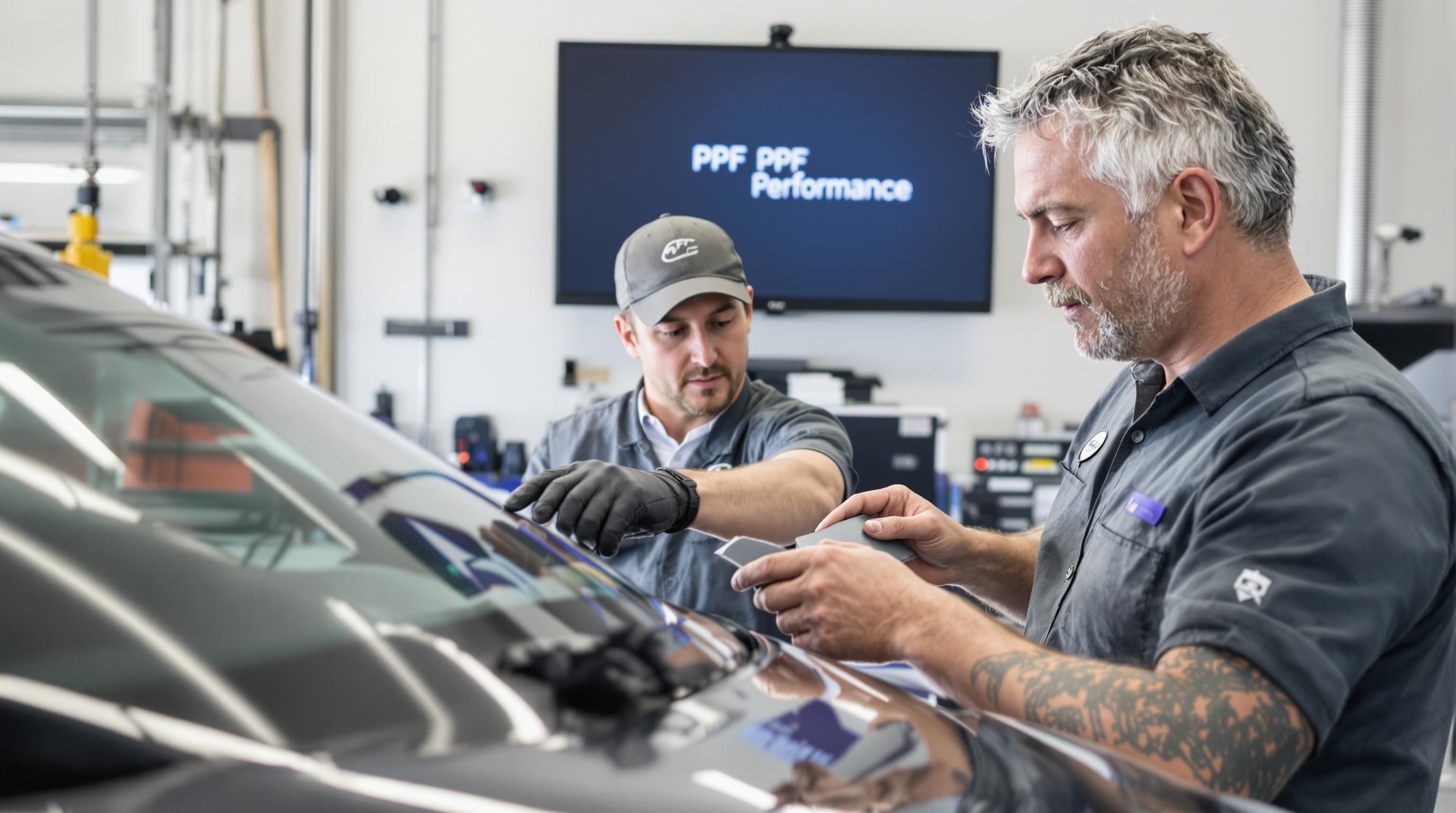
Frequently Asked Questions
What are the main benefits of Paint Protection Film (PPF)?
PPF offers superior vehicle protection against road debris, UV rays, and minor abrasions, ensuring the vehicle’s aesthetics and longevity are preserved. It also helps maintain resale value by preventing paint degradation.
How long does Paint Protection Film typically last?
Most PPFs have a lifespan of 5 to 10 years, depending on the environmental conditions and care taken. Regular maintenance can help extend its effectiveness.
Why is professional installation important for PPF?
Expert installation is crucial as improper application can lead to aesthetic flaws like bubbles or misalignment, compromising both the film’s protective capabilities and the vehicle’s appearance.
What are the main challenges associated with installing PPF?
Challenges include the complexity of installation, potential high costs, and the need for ongoing maintenance. Environmental factors can also affect the film’s performance over time.
Upgrade Your PPF Installation Process with Precision Patterns
Struggling with the real-world challenges of PPF installation highlighted in our latest article? Issues like misalignment, wasted material, and the need for perfect accuracy are more common than you think, especially with rising client expectations and the high cost of mistakes. If you want to deliver bubble-free finishes and perfect edges every time, you need more than just skill—you need the right tools.

Experience the future of automotive surface protection with AEONCUT. Our advanced cutting software provides you with an extensive library of pre-cut PPF patterns, designed to fit flawlessly and reduce waste. Unlock unlimited pattern access, immediate cloud updates, and full support to give your clients exceptional results. Transform your workflow and exceed customer expectations—visit https://aeoncutsw.com now to start your journey towards hassle-free PPF installation. Your next flawless application is just a click away.
Recommended
- PPF Cutting Software: Essential Guide for Installers 2025 – AEONCUT PPF Pre-cut Cutting software
- Best PPF Software 2025: Top Picks for Auto detailing businesses – AEONCUT PPF Pre-cut Cutting software
- Top Paint Protection Film Benefits for Auto Professionals 2025 – AEONCUT PPF Pre-cut Cutting software
- How Does PPF Work? Guide for Car Care Pros 2025 – AEONCUT PPF Pre-cut Cutting software

